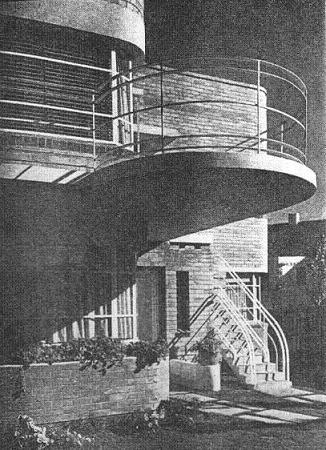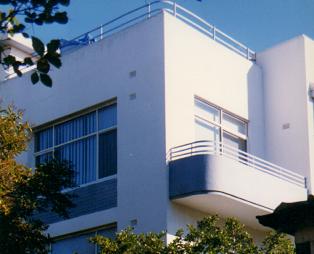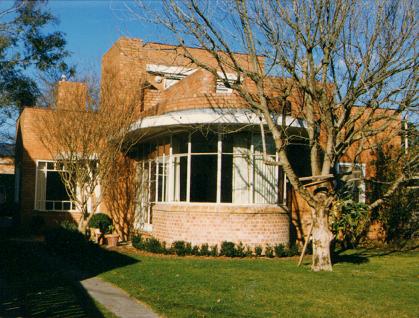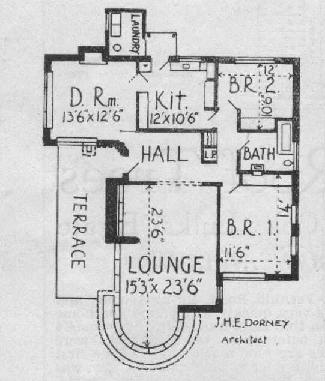J
H Esmond Dorney, who lived in Hobart from 1948 until his
death, is acknowledged as Tasmania's foremost modernist
architect of the post-Second World War period. However,
considerably less is documented of Dorney's earlier career in pre-war Melbourne,
where he was born, where he obtained his qualifications, and where
he practised as an architect for over a decade.
Born in Ascot Vale on 18 September 1906, James Henry Esmond Dorney was the oldest son of James Henry Dorney (1872-1962) and the former Mary Louise Kiernan (1878-1965). The family lived in the Essendon area for some years (where Dorney's father ran a billiard hall with an illegal betting shop out the back) but, by the late teens, had moved to the beachside suburb of Elwood. Dorney, who attended St Kevin's College in Toorak, was initially drawn to the profession of medicine, as there were already twelve doctors in the family. However, after his friend Frank Moriarty began studying architecture, Dorney decided to follow suit. In 1925, he commenced the Diploma of Architecture course at the University of Melbourne, but completed only two years before being expelled for racing cars around the university oval. In any case, Dorney felt no affinity with the way that the subject was taught there, later admitting that "I didn't enjoy it. There was no imagination... all old-fashioned teaching about buildings a hundred years old. I wanted something different, you see. I was interested in new things".
To complete his education, Dorney transferred to the Brighton Technical College, where he studied under R V Courtney, FRVIA. At the same time, Dorney joined the Melbourne architectural office of Walter and Marion Griffin through a recommendation from his maternal uncle, Esmond Kiernan (1881-1967), for whom the Griffins had designed a building in 1922. In this way, Dorney became an articled pupil of the Griffins, and spent a total of three years in their employ, from 1927-29. John Mason, who also worked in Griffin office at that time, remembered Dorney as "a little chap with tremendous muscles", with whom he shared a passion for physical fitness. Dorney himself remembered Walter Griffin as "a delightful man, always a gentleman", and his formidable wife, Marion, as "always excited, trembling, energetic". However, Dorney freely admitted that he was not especially fond of the Griffins' distinctive Prairie School style, which he once described as "rather solid, no lightness; his type of building was not my type at all".
One of Dorney's earliest known projects, which was apparently undertaken while he was still employed in the Griffin office, was a house in Clowes Street, South Yarra. As he once recalled, "friends of mine were building a house for themselves and, not liking their own design, ask me to do it for them. I redesigned the house and supervised is construction". The house was completed prior to 1930, as Dorney cited it in his application that year to become an Associate of the RVIA. After completing the necessary examinations, Dorney opened his own office in early 1931. Coinciding as it did with the crippling effects of the Great Depression, Dorney's new practice initially floundered. The paucity of commissions, however, allowed him to devote further time to professional development. During that year, Dorney received private tuition in structural engineering from Henry Allen, design engineer for the prominent firm of Johns & Waygood, and also took art classes under Allan Bernaldo (1900-1978), a well-known Melbourne watercolourist. It was also during this period, on 28 March 1931, that Dorney married a local girl from Elwood, Margaret Lambie; the couple had two sons, John and Earl.
Dorney's private practice finally began to boom from the early 1930s. He became especially prolific as a designer of modern blocks of flats, many of which were erected around Elwood, where he still lived, and the nearby suburbs of Brighton and St Kilda. His own mother, Marie Louise Dorney, became one of his most recurring clients; she not only engaged him to convert the family home, Chenier, into four flats in 1934, but subsequently commissioned two new blocks of flats, both also in Elwood, in 1939. The following year, Dorney designed yet another apartment block for a family member, this time for his father-in-law John Lambie, who was a prolific real estate agent in the area. Like many Melbourne architects of his generation, Dorney embraced a broad range of architectural styles, including Tudor Revival, Art Deco and Functionalist. Notwithstanding his stated dislike of the Prairie School style of Walter Burley Griffin, the latter's influence can nevertheless be discerned in a couple of Dorney's projects, notably the aforementioned Chenier renovation, and the Malaru flats in Brighton.
In February 1939, Dorney became the first official pupil of the Australian Air League, which had then extended its operations into Victoria. Following the outbreak of war later that year, Dorney attempted to enlist with the RAAF, only to be rejected due to his height. Instead, he joined the RAF and was commissioned on 26 April 1941. During the War, Dorney flew Tiger Moths over Singapore and was later taken as a Prisoner of War by the Japanese. Declared missing in action in 1942, he finally returned to Australia 3½ years later. While convalescing in the Heidelberg Repatriation Hospital, he met a nurse, Joan Mesley, whom he later married. After a visit to Hobart in 1947, the Dorneys settled there permanently in 1948. Over the course of the next four decades, Dorney rose to become "one of Australia's great architectural individualists". He died in Hobart on Christmas Day, 1991.
Born in Ascot Vale on 18 September 1906, James Henry Esmond Dorney was the oldest son of James Henry Dorney (1872-1962) and the former Mary Louise Kiernan (1878-1965). The family lived in the Essendon area for some years (where Dorney's father ran a billiard hall with an illegal betting shop out the back) but, by the late teens, had moved to the beachside suburb of Elwood. Dorney, who attended St Kevin's College in Toorak, was initially drawn to the profession of medicine, as there were already twelve doctors in the family. However, after his friend Frank Moriarty began studying architecture, Dorney decided to follow suit. In 1925, he commenced the Diploma of Architecture course at the University of Melbourne, but completed only two years before being expelled for racing cars around the university oval. In any case, Dorney felt no affinity with the way that the subject was taught there, later admitting that "I didn't enjoy it. There was no imagination... all old-fashioned teaching about buildings a hundred years old. I wanted something different, you see. I was interested in new things".
To complete his education, Dorney transferred to the Brighton Technical College, where he studied under R V Courtney, FRVIA. At the same time, Dorney joined the Melbourne architectural office of Walter and Marion Griffin through a recommendation from his maternal uncle, Esmond Kiernan (1881-1967), for whom the Griffins had designed a building in 1922. In this way, Dorney became an articled pupil of the Griffins, and spent a total of three years in their employ, from 1927-29. John Mason, who also worked in Griffin office at that time, remembered Dorney as "a little chap with tremendous muscles", with whom he shared a passion for physical fitness. Dorney himself remembered Walter Griffin as "a delightful man, always a gentleman", and his formidable wife, Marion, as "always excited, trembling, energetic". However, Dorney freely admitted that he was not especially fond of the Griffins' distinctive Prairie School style, which he once described as "rather solid, no lightness; his type of building was not my type at all".
One of Dorney's earliest known projects, which was apparently undertaken while he was still employed in the Griffin office, was a house in Clowes Street, South Yarra. As he once recalled, "friends of mine were building a house for themselves and, not liking their own design, ask me to do it for them. I redesigned the house and supervised is construction". The house was completed prior to 1930, as Dorney cited it in his application that year to become an Associate of the RVIA. After completing the necessary examinations, Dorney opened his own office in early 1931. Coinciding as it did with the crippling effects of the Great Depression, Dorney's new practice initially floundered. The paucity of commissions, however, allowed him to devote further time to professional development. During that year, Dorney received private tuition in structural engineering from Henry Allen, design engineer for the prominent firm of Johns & Waygood, and also took art classes under Allan Bernaldo (1900-1978), a well-known Melbourne watercolourist. It was also during this period, on 28 March 1931, that Dorney married a local girl from Elwood, Margaret Lambie; the couple had two sons, John and Earl.
Dorney's private practice finally began to boom from the early 1930s. He became especially prolific as a designer of modern blocks of flats, many of which were erected around Elwood, where he still lived, and the nearby suburbs of Brighton and St Kilda. His own mother, Marie Louise Dorney, became one of his most recurring clients; she not only engaged him to convert the family home, Chenier, into four flats in 1934, but subsequently commissioned two new blocks of flats, both also in Elwood, in 1939. The following year, Dorney designed yet another apartment block for a family member, this time for his father-in-law John Lambie, who was a prolific real estate agent in the area. Like many Melbourne architects of his generation, Dorney embraced a broad range of architectural styles, including Tudor Revival, Art Deco and Functionalist. Notwithstanding his stated dislike of the Prairie School style of Walter Burley Griffin, the latter's influence can nevertheless be discerned in a couple of Dorney's projects, notably the aforementioned Chenier renovation, and the Malaru flats in Brighton.
In February 1939, Dorney became the first official pupil of the Australian Air League, which had then extended its operations into Victoria. Following the outbreak of war later that year, Dorney attempted to enlist with the RAAF, only to be rejected due to his height. Instead, he joined the RAF and was commissioned on 26 April 1941. During the War, Dorney flew Tiger Moths over Singapore and was later taken as a Prisoner of War by the Japanese. Declared missing in action in 1942, he finally returned to Australia 3½ years later. While convalescing in the Heidelberg Repatriation Hospital, he met a nurse, Joan Mesley, whom he later married. After a visit to Hobart in 1947, the Dorneys settled there permanently in 1948. Over the course of the next four decades, Dorney rose to become "one of Australia's great architectural individualists". He died in Hobart on Christmas Day, 1991.
Select List of Projects
| 1929 1933 1934 1935 1936 1937 1939 1940 1957-64 1962 ?date | Residence, Clowes Street, South Yarra Flats (Surrey Court) for Surrey Court Pty Ltd, 71 Ormond Esplanade, Elwood Conversion of residence (Chenier) into flats for Mrs M L Dorney, 8 Glenhuntly Road, Elwood Flats, Northbrook Avenue, Malvern Flats, Wrexham Road, Toorak Maisonettes for R L Sinclair, Hampden Road, Armadale Flats (Winderemere) for C Habersbenger, 49 Broadway, Elwood Maisonettes for W Hill, Alexandra Avenue, South Yarra Maisonettes (Malaru), 33-39 Campbell Street, Brighton Flats (pair) for P & M Northey, Calulla Avenue, Toorak Flats (pair), 261-263 Williams Road, Toorak Residence for self, 9 Lefevre Street, Sandringham [demolished, despite heritage listing] Flats (St Kiernans) for Mrs M L Dorney, 51 Ormond Esplanade, Elwood Flats (Antigone) for Mrs M L Dorney, 34 Docker Street, Elwood Remodelling of residence for A Vale, 310 St Kilda Street, Brighton Flats (Garden Court) for J R Lambie, 73 Marine Parade, Elwood Brick veneer residence, Caulfield Sandringham District Hospital, Bluff Road, Sandringham [with Conarg Architects] Mesley Hall, Leongatha High School, Leongatha Caritas Christi Hospice, Studley Park Road, Kew [with Stephenson & Turner] Flats for Miss Prout-Webb, Alexandra Avenue, South Yarra Maisonettes, 2 Bay Street, Brighton [demolished] Flats (St Annes), corner Park Street and Toorak Road, South Yarra Residence for A Perry, 15 Park Crescent, Moonee Ponds |
 | |
| Northey Flats, Callula Avenue, Toorak (1937) |
 | |
| Detail of Antigone flats, Docker Street, Elwood (1939) (photograph by Simon Reeves, 1996) |
 | |
| Dorney's own house, Lafevre Street, Sandringham (1939) (photograph by Simon Reeves, 1996) |
 | |
| Plan of Dorney's own house, Sandringham (1939) |
| Select References "Obituary: J H Esmond Dorney, 1906-1991", Transition, No 36/37 (1992), pp 126-135 Rory Spence, "James Henry Esmond Dorney, 1906-1991", Architecture Australia, April 1992, p 10. Letter from the late Mrs Joan Dorney, 6 March 1996. |
